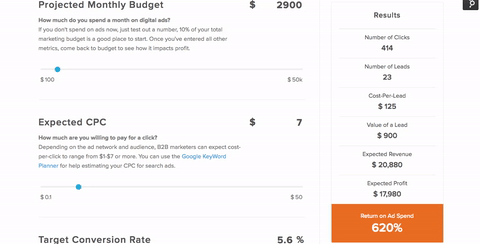
Marketers considering ads always ask me the same thing: “How much should I spend?”
It’s a good question — an important question — but it’s the wrong question. The right question is: “For every dollar I spend on ads, how much will I get back?”
If you know the answer to that question, or at least have an educated guess, it matters less how much or little you can spend. To help you figure this out, we’re launching a free tool called the HubSpot Advertising ROI Calculator.
This simple calculator allows you to explore how different metrics will impact the profit and ROI you can expect from ads. It will help you get the math right, so whether you have $100 to spend or $100,000, you won’t have to guess at the outcome.
Ready to give it a try? Click here to check out the HubSpot Advertising ROI Calculator.
How to Plan for Ad Spend Success
Too many marketers tell me about getting burnt by ads. They build an AdWords campaign to rank for important search terms, it drives clicks, traffic, and leads, but ultimately their ad spend outweighs the impact of the ads.
These marketers end up learning a really expensive lesson — one that could be easily prevented by following these simple steps …
1) Do the math.
Ads aren’t right for everyone. Some industries have extremely high competition with astronomical CPCs. Some products have too low of an average sales price for the economics to work.
To determine if ads are worth your time, run the numbers specific to your business through our calculator. With the tool you can explore how a change in numbers, a lower CPC or higher close rate for example, will impact a campaign. This will give you a better idea of what it will take to create an ads campaign that makes you money.
2) Never set it and forget it.
Try not to look at ads as a shortcut. It’s possible to get to a place with ads where they become a recurring source of profit … but typically that’s not how things start.
Don’t be surprised when a week after your campaign launches your ads aren’t generating tons of profit. Examine the data and make improvements to your ads targeting, creative, and landing pages.
Incremental improvements in clickthrough rates and conversion rates can have a huge impact on profit. Use the ads calculator to explore the impact these changes could have. Watch your ads like a hawk for the first month and you’ll avoid big mistakes.
3) Don’t place your ads in a vacuum.
Ads act like a megaphone to amplify your marketing campaigns and content. The more complete and well developed your campaigns are, the better your ads will perform.
Think about it: Which ads do you think perform better? Those promoting your homepage or those promoting a remarkable piece of content that helps someone?
Bingo. Those promoting awesome content.
Campaigns that use ads should be treated like other campaigns. Establish your goals first, build great content, focus your message and optimize your landing pages, then figure out how ads can help amplify your message. Taking this combined approach and only using ads as a strategic component of your marketing campaigns will pay off.
So how much should you actually spend on ads?
Assuming you’ve run the numbers and now know what you can expect in terms of profit and ROI, it’s time to launch a campaign. To do this you’ll have to make two budget decisions, regardless of where you are advertising:
- Total campaign budget or duration: How much do you plan to spend in total? How long will the ads run for? Be aware that if you don’t set a limit there will be no maximum or end date.
- Daily budget: How much do you want to spend a day?
There are two ways I see most marketers use ads, short-term and long-term. Let’s take a look a both …
Short-term ads. Budget = at least a few hundred dollars over a month.
When marketers use ads for a short-term goal, it’s usually to jump start a campaign or boost content that needs a bump. These ad spends are generally smaller and shorter, but can be large.
If you have a few hundred dollars to spend, spend it this way. Create a social post that promotes a piece of content and then use your ads to boost the post. Facebook, Twitter, and LinkedIn all have good solutions for this. Make sure you use the social network that gives you the best targeting for your persona and returns the most valuable leads. Measure this by assessing the quality of the leads generated after the campaign.
Long-term ads. Budget = at least a few thousand dollars over a quarter.
Ads can be a great solution in a pinch but if you really want to use ads strategically build them into your overall marketing strategy. This means more consistent, quarterly ad spends.
Consider how potential customers make purchase decisions and use ads to influence them. This may mean always relying on search ads or retargeting to make sure prospects find you when they are ready to buy. You’re more likely to accumulate better data taking this approach, which will allow you to get more sophisticated in how you optimize your ad spend.
Whatever budget you choose and whichever approach you take, make sure to ask a lot of questions about your ad spend. Even with the right approach, it’s easy to burn through money fast. Safeguard yourself by knowing what to expect and having clear expectations.



